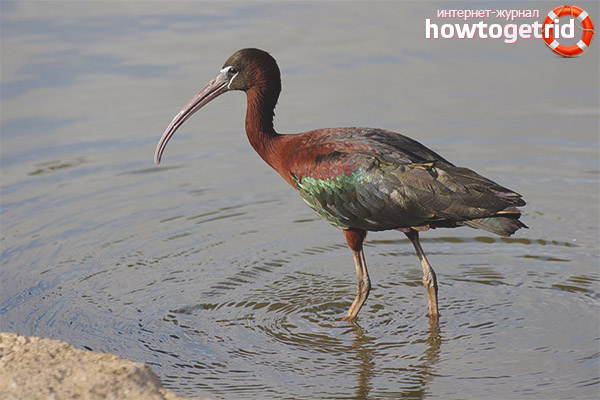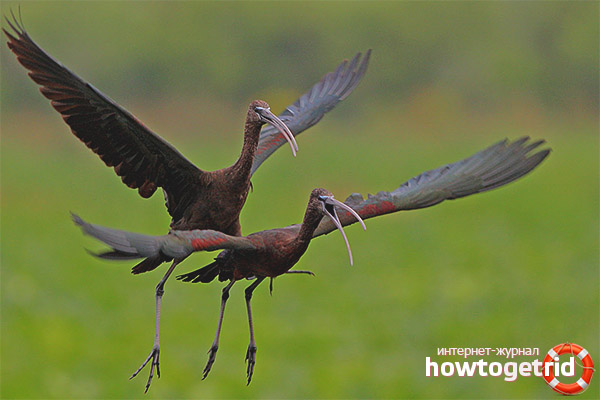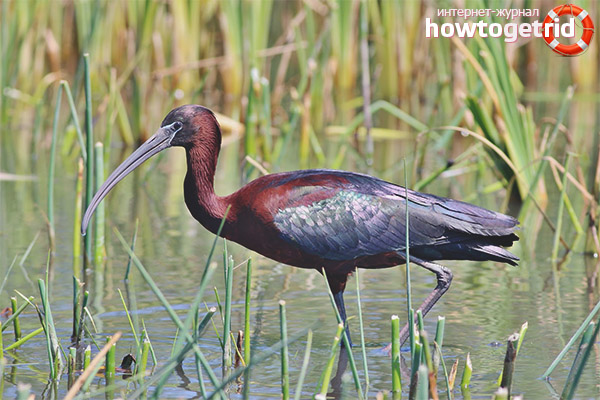The content of the article
The loaf is an interesting bird, which, according to the classification, is distributed to the order of storks and is related to the ibis family. Like most representatives of this family, these birds are ankled and medium in size. Despite the rather long legs, the ability to run is still not peculiar to them. Loafers also rise quite rarely into the sky, mainly only in cases when there is a real danger.
As for the habitat, it is quite large. These birds were found in Europe, Asia, Australia, America and Africa. Loafers do not live on their own. They can form whole colonies of individuals, however, they are kept mainly in pairs.
Individuals that live in temperate zones, as well as in the north, fly to other territories for wintering. For example, loafs living in Russia fly away to warmer places for the winter, namely to Asia and Africa. In the spring, around March, birds usually fly back. Karavayk nests are equipped either on the shores of various water bodies or in wetlands.
The appearance of loaves
A distinctive bright feature of these individuals is considered to be an unusual beak in the form of an arc, slightly directed downward. Its length can reach 12 centimeters. If you compare the loaf with storks, it can be noted that their length is slightly less than that of the congeners, however, this does not prevent the loaves from moving quietly through the wetlands.
Varieties
The ibis family today has 32 species of birds. The appearance of all these individuals has common features: long legs, small sizes, and also a beak in the form of an arc. Meet ibis representatives can be absolutely on all continents, with the exception of Antarctica. The closest relative of the loaf is the sacred ibis.
Lifestyle and behavior
As a rule, loaves for arranging nests select territories with reed beds or trees near rivers and lakes. Pelicans, spoonbills and herons often settle in the neighborhood with them. These nesting birds select areas that are difficult to reach. A great option would be small island parts in rivers, meadows flooded with water, as well as distant lakes.
Caravays are very active birds that almost never stand still. Almost all the time they go to places where they survey the bottom rather finely and with the help of their long and curved beaks. Periodically, such walks can stop for a while, then the loaves sit on a tree.
Diet
The basis of the diet of these birds is the living creature that the loaves find in water or on land, as well as a variety of plants. On the ground, birds usually meet larvae, beetles, butterflies, smoothies and weevils. As for aquatic living creatures, frogs, crustaceans, tadpoles and various small fish become the main food for loafs. Also, algae are included in the diet of birds. Interestingly, females and males have some differences in their tastes. Males eat snails more, but females like insects.As soon as the time comes for the active activity of frogs and tadpoles, they become the main food for loaves. When the locust invasion begins, the birds switch to insects, which is quite logical and rational.
Breeding
After the birds return from warm countries, the first thing they begin to equip their housing, to restore it after a long absence. Loafs approach this issue very carefully, gathering branches, grass, parts of reed and leaves. As a result, the nest is very voluminous.
The diameter of the nest can reach 50 centimeters, and a depth of up to 8 centimeters. In shape it is traditionally round, very neat. In most cases, birds place their nests on shrubs or trees so that future chicks are completely safe.
Three weeks later, chicks hatch into the light. From this moment, the main task for parents is to get food for their chicks. While the kids are growing, during the day they can eat up to 11 times. Over time, the number of meals is gradually reduced. Chicks feed directly from the beak of their parents.
Chicks of loafs are covered in black down. Before reaching adulthood, they change their color and fluff about 4 times, after which they begin to become covered with feathers. Three weeks after hatching, the chicks are already trying to stand on the wing. At this time, they still fly extremely poorly, able to overcome only small distances. Upon reaching the age of 4 weeks, the chicks can already fly independently and together with their parents get their own food. Already at the end of the summer, the first serious flight to the winter awaits the chicks. Under natural conditions, the life expectancy of loaves is on average 20 years.
Video: loaf (Plegadis falcinellus)












Submit